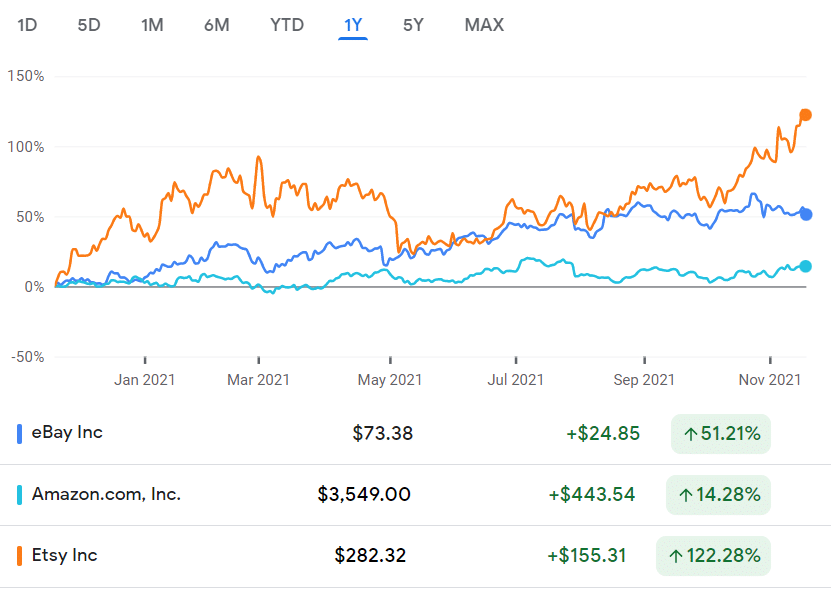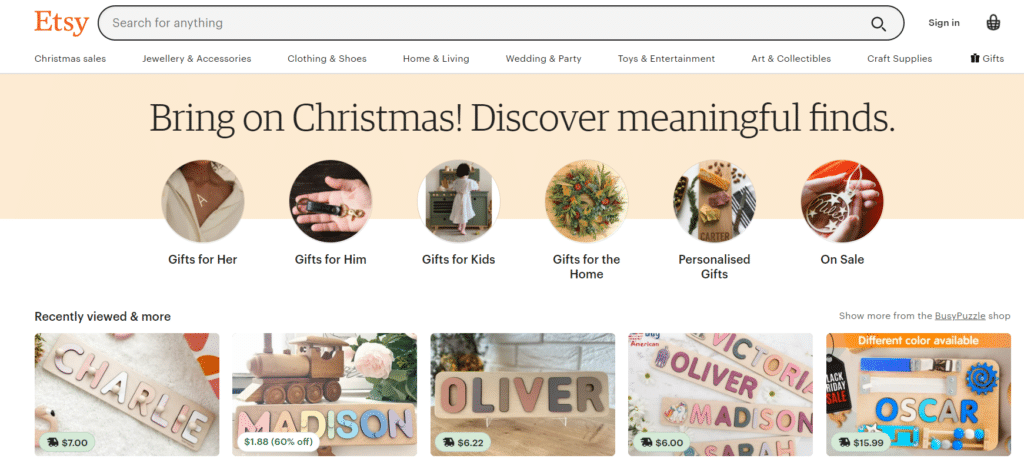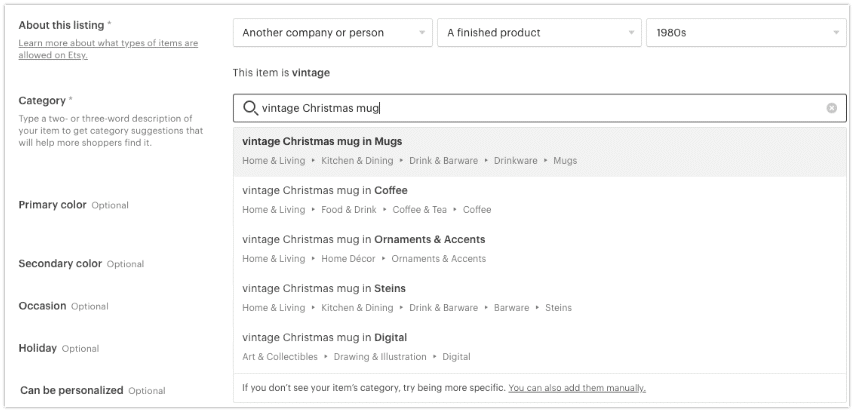Selling on Etsy in 2023: Is It Worth It?

There are plenty of ecommerce platforms for sellers to sell their products, but there are just a few that specialize in selling handmade items and with an established audience. Etsy is one of them.
In this article, we’ll look at the pros and cons of selling on Etsy to help you decide whether it’s right for your business.
Related Reading: Amazon Handmade vs. Etsy [2022 Guide]
Contents
What Is Etsy?
Etsy is an online marketplace like Amazon or eBay, but unlike these platforms where you can sell almost anything, on Etsy you can only sell handmade products, vintage (objects over 20 years old), or materials for crafts.
Handmade products can be made by you, or you can sell items made by other people as long as they fall in the vintage category or the craft supplies.
So you don't have to be a crafting genius to sell on Etsy. You can also look for distributors of crafts supplies and sell them on the platform, or buy old clothes, decorative objects or accessories in places like flea markets and put them on sale on Etsy.
But remember, reselling isn’t allowed in the Handmade category. Every product listed in Etsy's Handmade category must be made or designed by you (the seller) or someone who is part of your business. Reselling is only allowed in the vintage and craft supplies categories.
Etsy vs. Amazon: How Big Is Etsy Compared to Amazon?
There are over 4.3 million registered sellers and 81.9 active buyers as of 2020 in the Etsy marketplace, and the site's average daily traffic figures are huge. In fact, according to Ahrefs, it is currently the 110th most trafficked site in the US, with over 67 million monthly visits.
Etsy’s market share is small compared to giants like Amazon. In 2020, the platform made $1.7 billion in revenue. In contrast, Amazon generated $386.1 billion in revenue and eBay $10.271 billion. However, Houzz is below this one, with $253 million in revenue during 2020.

Etsy represents only a small part of the ecommerce market share next to Amazon or even eBay. However, they do have very different target audiences. With Etsy, you can trust that the vast majority of buyers are there looking specifically for handmade and vintage items.
Because of the specificity of the audience on Etsy, you can’t expect that many sales from your Etsy store compared to other giant platforms.
What Are the Pros and Cons of Selling on Etsy?
Selling on other platforms such as Etsy is a way to start or expand your ecommerce business, but is starting an Etsy shop the best option for you or should you use Amazon, or as many have done, start your own website using Shopify, WooCommerce, or another ecommerce platform?
Check out some of the advantages and disadvantages of selling on Etsy below:
Etsy Pros
- Easy to set up and use
- Established audience
- Access to a forum for sellers
- Etsy’s algorithms help new listings
- The listing fee is cheap
- Appears in Google searches
- Access to analytics tools
- Access to advertising tools
- Allows sale of digital products (prints, workbooks, digital planners, clipart images, SVG and DXF files)
Etsy Cons
- Competitive market and prices
- Difficult to rank in Google searches
- Market focus on handmade and vintage items and craft supplies only
- Presence of copycats
- Poor seller support
- Not allowed to collect shoppers’ emails
- Saturated market
- Limited branding
- Limited by your own production facilities
- For most products sold on Etsy, the manufacturing is time-consuming for sellers. They have to make the product and manage the brand at the same time.
- Your inventory depends on the speed of your labour
- You need to ship the orders yourself
What Can You Sell on Etsy?
Etsy is a vintage and handmade marketplace and is ranked top in the category by most handmade businesses.
Here’s the bad news: If you want to list a product on Etsy, it must be handmade, is vintage, or is a craft supply. Therefore, you cannot import and manufacture on Etsy the same way sellers can do on platforms such as Amazon or eBay with their private label products. You can, however, manufacture your product through a manufacturer, but it must be your own design.
Check Out Our Free Guide
If you are looking for ways how to manufacture and import a product from China, take a look at our guide on How to Find the Right Product to Import from China and Sell On Amazon in 2022.
- Handmade products must be designed and/or made by the seller.
There are two types of handmade products on Etsy: those that are designed and made by the seller and those that are only designed by the seller but made by someone else.
For the first type, sellers are called “makers.” Under this category, you have to be involved in the process of making the items with your own hands (or tools) in order to list them on Etsy.
Also, you have to include each person that was involved in the process of making and designing the item in the About section, and use your own photographs when listing your products.
For the second type, sellers are called “designers.” They come up with an original design, pattern or prototype, but they don’t make the actual product
For example, you can design the graphics for a t-shirt, but you don't need to manufacture it yourself. As a designer, you are allowed to ask for assistance to help manufacture the item.
- Vintage products must be 20 years old or older at the time that the seller lists them. You cannot list newer items even if they have a vintage style. These items don’t need to be handmade or functional.
- Craft supplies are items that shoppers can use to create crafts. These include tools, materials, or ingredients.
For example, you can sell tools that people that sew might use to create handmade cloth, but you cannot sell mass-produced scarves that have been made by a manufacturer.
Finally, in order to sell on Etsy, you must have at least one product to list at the same time you open the store, so keep that in mind.
Of course, as in other ecommerce platforms, there are products that are prohibited, such as alcohol, weapons, drugs, etc.
Examples of Prohibited Reselling Products
- Selling items made or designed by another seller who is not part of your shop.
- Selling traditional handicrafts or fair trade items that you did not design or make.
- Repackaging commercial items (for example a gift basket consisting of non-handmade items).
- Restore a collection of others’ handmade goods that you did not design or make.
Seller Fees on Etsy
It's free to register on Etsy, but there are two main Etsy listing fees that you will encounter every time you list an item and make a sale.
- Listing fee. Every time you list a new item, you will be charged $0.20. This is not only charged the first time you list but each time the product is sold and then put back up for sale.
- Transaction fee, which is charged each time you make a sale. Etsy will deduct 5% from the list price displayed.
For example, if you sell an item for $20, and the shipping costs are $3, Etsy will only charge you 5% of that $20, which would be $1. If you don't sell the item, Etsy won't charge you anything.
Then there are some other fees and costs that may or may not be charged, depending on the type of product you are selling, like shipping costs, taxes, or advertising.
Should You Sell on Etsy?
Well, you can start selling on Etsy as an extra sales platform and have a robust platform like Amazon or eBay as your main source of sales, but this will depend on the kind of product that you’re offering. Remember that you can only sell craft supplies, and handmade or vintage products on Etsy.
If you’re looking to make more sales, you shouldn’t put all your eggs in the Etsy basket. You probably should consider creating your own website, like Shopify or Woocommerce.
If you are selling mass-produced goods and want to scale, Amazon may be more appropriate in this case.
Of course, if you have a unique product to sell and you want to create a brand out of your creativity, definitely Etsy is the platform for that.
Another thing to consider is that although there are customization options on Etsy, the design of each online store on this platform is quite limited and you will not be able to show the essence of your products or creations.
Conclusion
Etsy is an e-commerce platform that has a specific target audience, so it’s not for everyone. If your products do fit the description, it’s a good place to sell on, whether as your sole store or as an addition to other marketplaces.
But as we mentioned before, you should never put all your eggs in a single basket, especially in terms of growth. Etsy can help increase your income, but you shouldn't just depend on it.
Do you sell on Etsy? If so, is Etsy your platform's main source of sales? Let us know in the comments section below!








Etsy does not sell only vintage and handmade items. They allow people to sell junkie stuff that the seller just keeps ordering and stocking from other countries and places. UNFORTUNATELY. Also, they allow people to deceitfully write 14k,18k, 22k gold without mentioning that the product is only PLATED! Ugh. Yuck!
Etsy needs to monitor these falsely advertised items and kick them out.
I started by selling on Etsy, and while Amazon has way outpaced it in terms of sales, I keep my Etsy store up as it still provides a steady stream of sales.
My own experience was that it was MUCH easier to get started on Etsy as someone new to ecom, and because Etsy has a lot of pre-existing traffic / customers, it was a good way to launch a product and find out if there was interest in it.
Once I had proof that my products were selling on Etsy I knew it was worth building out a Shopify store and going through the hoops to get set up on Amazon.
Definitely a worthwhile channel, and I think their definition of what’s “handmade” has a lot of stretch in it. I create products that are made in China, but they’re well designed products and the design aspect qualifies them for Etsy…
I agree, Mike. If you are new to the world of ecommerce, Etsy is a good place to start, especially if the design aspects of your products qualify for Etsy. Glad to hear that you are growing your business and that you have reached more ecommerce channels!